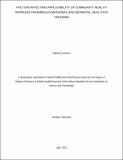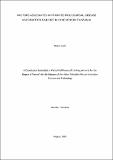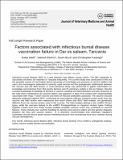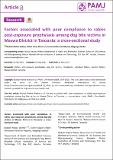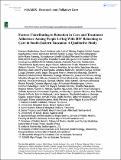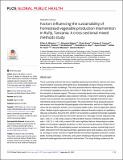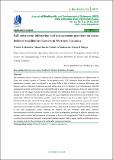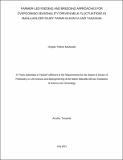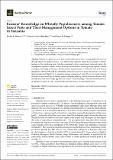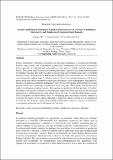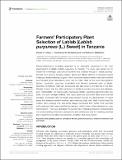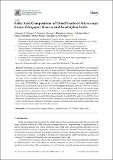Browsing Life sciences and Bio-engineering by Title
Now showing items 468-487 of 1195
-
Fabrication of liposome-chitosa N-ZnO nanohybrid integrated with Carissa Spinarum extract for antibacterial application
(NM-AIST, 2023-08)Innovative biomaterials provide a stimulating and adaptable platform for the implementation of new and more effective methods to prevent bacterial infection. Built on biomimetic inorganic hybrid material, Dual Nanohybrid ... -
Factors affecting applicability of community health workers trainings in maternal and neonatal health in Tanzania
(NM-AIST, 2021-07)Maternal and neonatal mortalities are global public health of concern and are estimated to cause about 830 women deaths every day, of which 99% are from sub-Saharan African countries. In Tanzania maternal and neonatal ... -
Factors associated with hypertension among employees in arusha city, Tanzania
(NM-AIST, 2021-12)Tanzania is one of developing countries with a higher prevalence of hypertension than many other developing countries. Healthcare workers, teachers and bankers are occupation groups exposed to hypertension due to the ... -
Factors associated with infectious bursal disease vaccination failure in chickens in Tanzania
(NM-AIST, 2020-08)Infectious bursal disease (IBD) is a viral infection that affects young chicks. The IBD outbreaks in vaccinated chickens are frequently reported in Tanzania. The current study was conducted to determine the possible ... -
Factors associated with infectious bursal disease vaccination failure in Dar es salaam, Tanzania
(Journal of Veterinary Medicine and Animal Health, 2020-09)Infectious bursal disease (IBD) is a viral infection that affects young chicks. The IBD outbreaks in vaccinated chickens are reported in Tanzania frequently. The current study was conducted to find out the possible causes ... -
Factors associated with poor compliance to rabies post-exposure prophylaxis among dog bite victims in Maswa District in Tanzania: a cross-sectional study
(Public health, 2024-05-22)Introduction: administering rabies post-exposure prophylaxis (PEP) in a timely and appropriate manner remains the most fundamental measure for preventing human rabies. However, a number of barriers to accessing and ... -
Factors associated with stunting in Dodoma region, Tanzania
(African Journal of Food, Agriculture, Nutrition and Development, 2018-12)Child undernutrition is a major public health concern, claiming the lives of numerous children below five years of age in the developing world. The objective of this study was to assess the factors associated with stunting ... -
Factors Contributing to Retention in Care and Treatment Adherence Among People Living With HIV Returning to Care in South-Eastern Tanzania: A Qualitative Study
(Taylor & Francis online, 2025-02-04)Background People living with HIV (PLHIV) with good adherence to antiretroviral therapy (ART) achieve good health outcomes. However, treatment interruptions remain a major challenge, particularly in rural Africa. This ... -
Factors influencing the sustainability of homestead vegetable production intervention in Rufiji, Tanzania: A cross-sectional mixed methods study
(PLOS Global Public Health, 2022-09-20)There is growing evidence that home vegetable gardening interventions improve food security and nutrition outcomes at the family level. Sustainability of many of these community interventions remain a challenge. This study ... -
Factors Influencing Willingness to Pay for Multiple Micronutrient Powder (Virutubishi) Supplements for Young Children in Arusha, Tanzania
(Journal of Health & Medical Economics, 2018-11-21)Background: Multiple micronutrient powders have shown a positive effect on anaemia prevention in children 6-59 months. For the purposes of uptake and sustainability, we explored ‘‘willingness to pay’’ for these health ... -
Fall armyworm infestation and management practices on maize fields of smallholder farmers in Northern Tanzania
(Journal of Biodiversity and Environmental Sciences (JBES), 2019-10-30)Fall armyworm (FAW) is native to America and is currently affecting maize production in different parts of Africa, and recently reported in Tanzania. In the present study, FAW infestation levels and their associated ... -
Farmer-led feeding and breeding approaches for overcoming seasonality-driven milk fluctuations in smallholder dairy farms in Kenya and Tanzania
(NM-AIST, 2021-07)Seasonality-driven changes in farmer-led feeding and breeding approaches are increasingly captured as contributing to fluctuations in milk yield and reproductive performance of dairy cows in smallholder dairy farms in ... -
Farmers’ insights and practices on sustainable soil nutrient and pest management in semi-arid Eastern Africa
(MDPI, 2025-03-12)The need to increase agricultural production for food, fiber, and feed for a growing population is a global call. Sub-Saharan Africa currently experiences declining soil fertility and increasing pest pressures affecting ... -
Farmers’ Knowledge on Whitefly Populousness among Tomato Insect Pests and Their Management Options in Tomato in Tanzania
(MDPI, 2023-02-13)Whitefly is a populous insect pest among tomato insect pests, causing significant crop loss through direct and indirect attacks. The current study aimed to assess the knowledge of tomato farmers on the populousness of ... -
Farmers’ Knowledge, Perceptions and Practices in Managing Weeds and Insect Pests of Common Bean in Northern Tanzania
(MDPI, 2019-07-28)Weeds and insect pests are among the serious constraints in common bean production in most rural communities. A survey of 169 smallholder farmers was conducted in two common bean-growing districts in northern Tanzania. ... -
Farmers’ participatory breeding of Lablab (Lablab purpureus (L.) Sweet): A nutritional, food security and climate smart crop in northern Tanzania
(Research application summary, 2022)Farmer participatory breeding is considered an alternative technique to conventional breeding. Farmers play a major role in germplasm conservation, maintenance and selection of preferred traits especially in neglected ... -
Farmers’ Participatory Plant Selection of Lablab (Lablab purpureus (L.) Sweet) in Tanzania
(Frontiers in Plant Science, 2022-06-23)Farmer-participatory breeding approach is an important component in the crop improvement of lablab (Lablab purpureus (L.) Sweet). The study was carried out to obtain the knowledge, practices and preferences of lablab ... -
Farmer’s Knowledge on Thaumatotibia Leucotreta (Meyrick) an Economic Pest of Avocado Production in Tanzania
(Taylor & Francis online, 2025-01-20)Thaumatotibia leucotreta (Meyrick) is a Lepidopteran pest that feeds on more than 70 plant species, both wild and cultivated. A study was carried out in Tanzania to assess farmer’s knowledge regarding the invasion of pests ... -
Farming systems and soil fertility management practices in smallholdings on the southern slopes of Mount Kilimanjaro, Tanzania
(Frontiers, 2024-02-16)In the northern part of Tanzania, the slopes of Mount (Mt.) Kilimanjaro are the most important areas, both in terms of socio-economic development and ecological succession. The main agricultural systems in the area are ... -
Fatty Acid Composition of Dried Fruits of Sclerocarya birrea, Diospyros blancoi and Landolphia kirkii
(MDPI, 2017-11-17)Wild fruits are commonly consumed in the rural communities of SouthAfrica. The information on their nutritionally important fatty acids is, however, limited. Threewild fruit species, Diospyros blancoi, Landolphia kirkii ...


